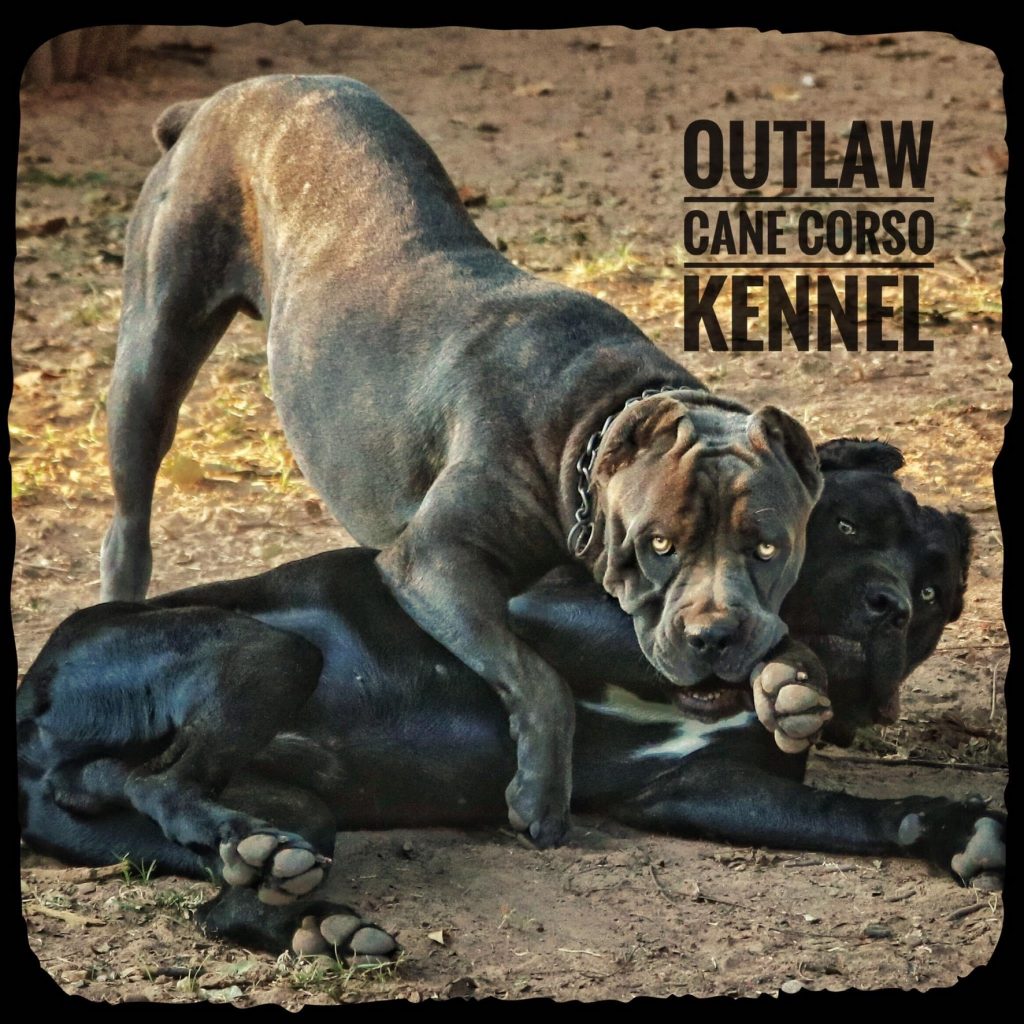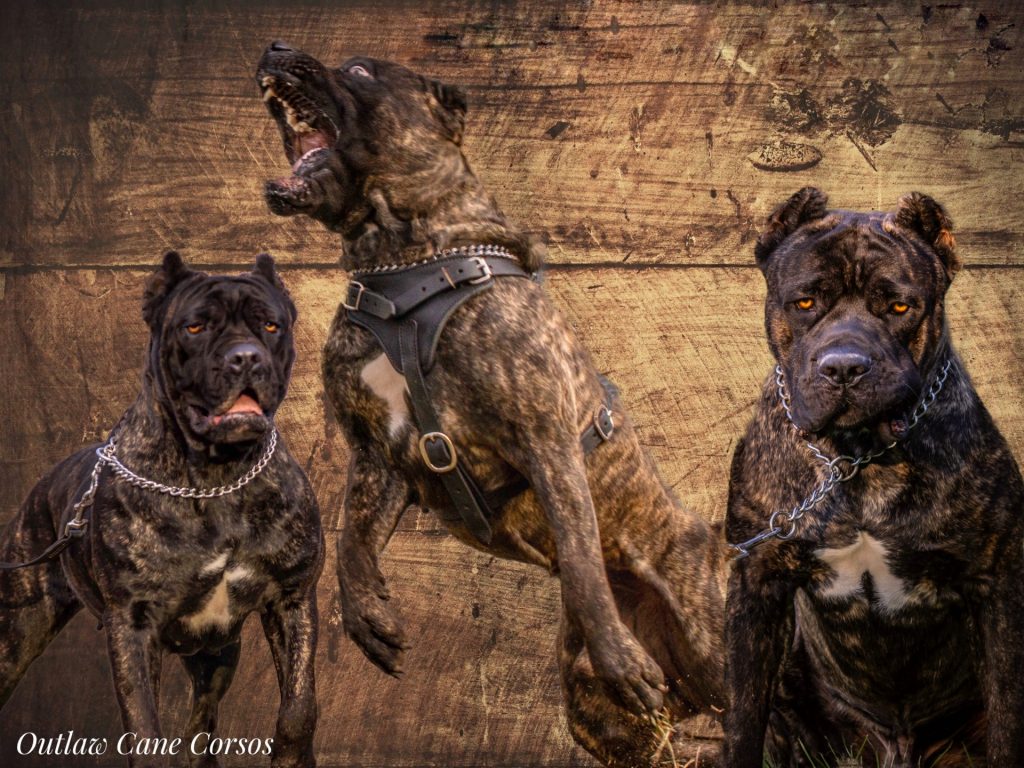The following is an article prepared for Outlaw Cane Corsos by Dr. Paolo Breber (the world’s leading expert on the Cane Corso and person directly responsible for the recovery of this breed in Italy). With the gracious help of Dr. Breber we will try to provide the most accurate information about this breed here in the United States. Please feel free to share this site with other Cane Corso enthusiasts. Help keep this very old traditional breed alive and true.
The bite and jaws of the Cane Corso. Paolo Breber.
Judged by its conformation according to the classification of Pierre Mégnin (1889) the Cane Corso is a typical “molossian” (this is the same as saying “mastiff”) whereas, when considered functionally, it is a “catch dog”. The focal feature of a catch dog is the holding bite with which it fastens onto its adversary, tires and overcomes it. The holding bite is different from the ordinary bite in that the grip becomes locked and the animal shuts its mind off, becoming insensible to anything that might be happening to it. The paradigm of this behavioural trait is to be found in an episode from the saga of Alexander the Great. Having crossed the Hydaspes River (the present Jehlam River in Punjab) and beaten King Porus, the conqueror was then met and entertained by king Sophites. In the course of ensuing festivities, the king, wanting to impress Alexander with the valour of his catch dogs, unleashed four onto a lion which was duly attacked and held. One of the king’s archers then entered the pit and cut a leg off one of the dogs. But the dog did not let go. The other legs were also severed but the dog died with its jaws still locked. Today, after more than two thousand years and many turns of history, this remains the same prized behavioural trait when the work of a catch dog is described. An example for all is the American Pit Bull Terrier, a dog which still has the good fortune of being bred for work. Those that use this breed say you must look for the “holding dog”; the one that will hang on to its adversary (boar, razorback, steer) even at the cost of its life. How did this behavioural trait arise? One explanation could be that it is the same instinct that makes a puppy hang on for dear life to its mother’s dug. The number of puppies in a litter is often in excess of the available dugs and it is a grim battle for survival that is fought for the source of nourishment because the losers are doomed to weaken and die. Once a puppy has fastened onto a dug it is in a state of bliss and nothing will detach it before it is gorged, and this is much the same mental state of a Cane Corso with a hold. At this point it is significant to recall how the old-timers of the Cane Corso proceed to choose those puppies to keep and those to cull soon after birth. The man first waits for the litter to begin suckling in earnest and then calls the bitch to him. As the bitch gets up and walks a few steps, he notices which of the puppies stays hanging on the dugs. These will be the best.
If a powerful holding bite is the very essence of the Cane Corso then it follows then that its jaws should be mechanically perfect. The upper and lower jaws should be of the same length and the teeth should be completely developed and interlock without fault. This is the condition dictated by nature and is therefore the most functional.
In molossian dogs undershot jaws appear frequently but it is an error to interpret this condition as a functional adaptation, as is often done, because it is simply a deformity. It seems that undershot jaws appeared in some molossian breeds when they were being transformed from working dogs to fancy dogs. As a pet the catch dog is not used any longer in its original capacity but it is still expected to visually inspire the part. Thus a big head, a stubby muzzle and a jutting jaw were developed in order to obtain that truculent expression assumed to be that of a fighting dog by the pet-dog owner. In the bear- and bull-baiting days the dog the English used was like the American Pit Bull Terrier but when the blood sport was banned in 1835 the dog developed into the English Bull Dog of today: from a highly functional but relatively nondescript animal to a highly expressive one but functionally very handicapped. There is some evidence pointing to the British as responsible for spreading the undershot mandible around the world. The great reputation of British dogs has caused the defect to uncritically contaminate the molossian-type dogs of other countries.
The undershot condition is not caused by the lengthening of the lower jaw but by the shortening of the upper jaw and nose. It determines a loss of efficiency in the use of teeth not only in the holding bite but also in mastication and in the care of the epidermis. Furthermore, a short nose causes problems in breathing and ventilation as witnessed in the forever open mouth of the English Bulldog, Boxer, Pug, Pekinese, and of other prognathous breeds. The canine brain requires a lower temperature than the rest of the body and it is cooled by air inhaled into the nasal cavity. Thus dogs with short noses have little resistance to protracted physical exercise because they quickly become overheated.
The incisor teeth are used by the dog for nipping, getting at fleas and other problems of the skin, but if the bite is “even” they wear down quickly and lose their efficiency. An “inverted scissors bite” is a more serious handicap because it often leads to the undershot condition where all the upper and lower rows of teeth do not meet properly. This impairs mastication and sometimes keeps the dog from closing its mouth properly, making it drool all the time. In my experience, a true Cane Corso should never present this condition. Where the Cane Corso is bred for work the undershot jaw stays away. On the other hand, the inverted scissors bite, the initial stage of the undershot condition, does in fact crop up here and there in the breed. This condition may be tolerated if the rest of the teeth lock correctly but it should not be encouraged and preferably weeded out


